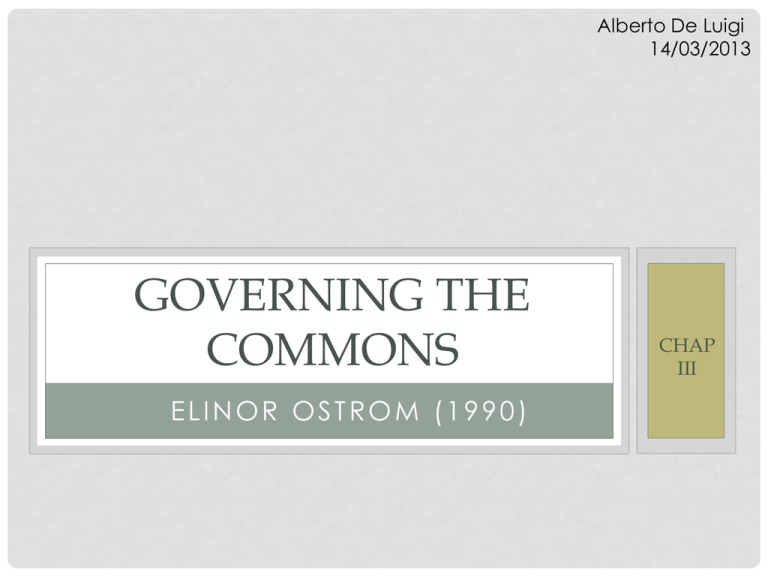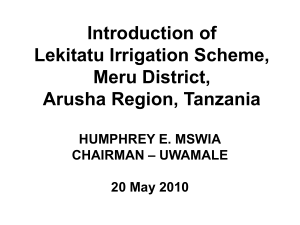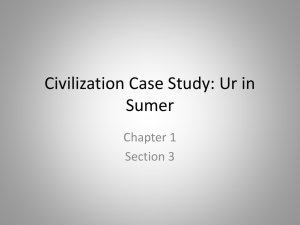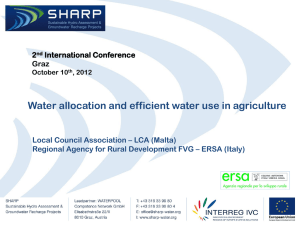governing the commons: Chap. iii
advertisement

Alberto De Luigi 14/03/2013 GOVERNING THE COMMONS ELINOR OSTROM (1990) CHAP III WHAT ARE THE CPRS (COMMON POOL RESOURCES) The CPRs are natural or man-made resource system: • The use and benefits of CPRs are not excludable, without costs, to potential beneficiaries • The overexploitation of CPRs can harm the stock of resources itself (tragedy of the commons) In-depht analysis EXAMPLES OF CPRS • • • • Fisheries (seas or rivers) Grazing lands (meadows) Forests providing timber Irrigation systems (water, canals) HOW TO AVOID THE TRAGEDY OF THE COMMONS • CENTRALIZATION: the state imposes sanctions and punishments, ensuring that everyone cooperates. Problems: no complete informations, costs in monitoring and administration. The state could fail. • PRIVATIZATION: assigning the property rights on these resources Problems: 1) it presumes the existence of a central authority and its costs 2) it’s difficult to create property rights to fugitive resources 3) dividing the commons may impoverish who benefits from them THE THIRD WAY • The third way is represented by the long-enduring, selforganized and self-governed CPRs • They are actually commons, with a system of appropriation and the parallel existence of private property: appropriators use or consume resources, or «immediatly transfer ownership of resource units» • Long enduring: they survived for long periods. They are «robust» or in «institutional equilibrium» as meant by Shepsle (1989): changes in according to an ex ante plan • Self-organized and self-governed: we will see these features through the examples TÖRBEL IN SWITZERLAND Mountain meadows and forests • Uncertain environment: Different microclimates due to: 1. Steepness of slope and wide range of altitude 2. Paucity of precipitation 3. Exposure to sunlight TÖRBEL IN SWITZERLAND Mountain meadows and forests • Social structure: All the citizens vote the village statutes that provide an alp association (originally established in 1483) with annual meeting to manage the alp The association elect officials: they hire the alp staff, impose fines (they keep ½ of the fine for themselves), organize the distribution of manure and annual maintenance work (paths, corrals..) TÖRBEL IN SWITZERLAND Mountain meadows and forests • The «cow rights»: in summer (period for grazing) each cow sent by a family to the mountain must be counted. The amount of cows determine: 1. The portion of land they can appropriate for grazing 2. The amount of cheese and timber (wood for construction and heating) the family will receive at the annual distribution TÖRBEL IN SWITZERLAND Mountain meadows and forests • Cutting trees for timber: 1. The officials mark the trees ready to be harvested 2. The households organize work teams for cutting trees (dividing the work equally) 3. The timber is collected in equal stacks 4. A lottery assign particular stacks to the households TÖRBEL IN SWITZERLAND Mountain meadows and forests • Inheritance system: appropriation rights and provision duties are inherited by individual males who own private property in the village ad remain citizens of the village • Population-control measures: late marriages, high rates of celibacy, long birth spacing, considerable emigration FEATURES OF THE TÖRBEL COMMONS • Uncertain environment • Appropriation and private property goes side-by-side • Individuals live side-by-side year after year, they expect their children and grandchildren to inherit their land: their discount rates are low • They spend time governing themselves, but the rules and monitoring systems require relatively low costs • (more the 5 Netting conditions) VILLAGES IN JAPAN Mountain meadows and forests • Uncertain environment: many different microclimates • Social structure: a village that contains a defined number of households (since at least 1600) • Inheritance system: an household (with rights on the commons) cannot divide itself without the permission from the village • Population-control measures: households with many members have considerable disadvantages in their access to the commons (pop. growth extremely low) VILLAGES IN JAPAN Mountain meadows and forests • Land for winter fodder are assigned with annual rotation. The cutting starts as the bell tolls; the hay cut is collected in equal bundles and assigned by lottery • There are written rules about the obligation of each household to contribuite a share to the collective work (as creating firebreaks for annual burning) • Detectives hired by the villages (or eligible males rotate into these positions) patrol the commons looking for unathorized users VILLAGES IN JAPAN Mountain meadows and forests • Punishments for the offenders: Fines are imposed with escalation penalties, depending on the past behaviour of the offender Fines are paid to the detective (cash and saké for light infractions) The contrabanded harvest is retained by the village until the violator has paid an extra fine to the village The most serious sanction is the banishment from the village HUERTA IRRIGATION INSTITUTIONS IN SPAIN Irrigation systems Uncertain environment: limited quantity of rainfall and variation from year to year. All the systems are successful: • Valencia has the least efficient system • Murcia-Orihuela is in the middle • Alicante is the most efficient (national authorities have here more control) VALENCIA IN SPAIN Irrigation systems • Social structure: • Farmers meets every two (or three) year (since 1435) to elect: 1. the syndic for their canal (manage waterworks, fines) 2. other officials 3. The Junta de gobierno (an executive commitee) The Tribunal de las aguas is a water court that for centuries meets every thursday morning VALENCIA IN SPAIN Irrigation systems • Distribution of water: Each farm receives water in a rotation order, from the head to the tail end of the canal If a farmer fails to open his headgate when water arrives, he misses his turn. No one knows exactly when it arrives When water arrives the farmer can take all the water he want (without wasting it) In periods of drought: rotation scheme is modified, given priority to farms whose crops are in the most need of water VALENCIA IN SPAIN Irrigation systems • Monitoring systems: Review the decisions of syndics; is composed by the syndics Tribunal de las Aguas Elected by farmers, watch the ditch-riders, impose fines to the farmers, manage waterworks Syndics Consult with the sindycs Executive committee Elected by the farmers Ditch-riders patrol the canals, paid by the farmers Irrigators Since they don’t know when exactly water arrives, while they are waiting they can monitor ditch-riders and other farmers MURCIA AND ORIHUELA IN SPAIN Irrigation systems • Distribution of water: Each farmer is assigned a «tanda», a period in which he may withdraw water In case of drought the officials post a new schedule for rotation • Justice: - Murcia: The Council of Good Men is a water court composed by 5 syndics and 2 inspectors (chosen by lottery over 30 communities) - Orihuela: court with only 1 judge Procedure: oral, public, summary and cheap (as in Valencia) ALICANTE IN SPAIN Irrigation systems • Rights to withdraw water separated from ownership • Private water companies sell rights to the water supply • Price of water varies in relation to the amount available • Who has contribuited to the construction of the new Tibi Dam has rights to the «new water» supply created by the dam • Rights to «old water» supply (previously acquired) can now be sold or rented only to those who own land eligible to receive «new water» ALICANTE IN SPAIN Irrigation systems • Social structure: a general assembly meets annually to approve budget and taxes, assessed against the holders of water rights the assembly decides matters brought before it by the executive commission both are costantly looking for new water and contractual arrangements with private firms ALICANTE IN SPAIN Irrigation systems • When purchasing scrips (rights on water supply): - Informal market on Sunday morning - The formal auction on Sunday - On market days • When farmer wants to irrigate, tells to his ditchrider, who opens the headgate (in the other huertas farmers do it themselves) • Given the water, scrip will turn in ZANJERA IRRIGATION COMMUNITIES IN THE PHILIPPINES Irrigation systems • Social structure: The Zanjera federation incorporates many zanjeras, the smallest one with 20 members, the larger 73 (1980 data) The federation is formally a «private corporation», it has the status of «juridical person» in the Philippine Water Code and therefore is eligible to obtain water rights Each zanjera is responsible for its own financial and internal affairs and owes no financial obligations to the federation Each one has a border of directors, the chairman is called maestro. They elect also a cook and other officials ZANJERA IRRIGATION COMMUNITIES IN THE PHILIPPINES Irrigation systems • Zanjera membership («sharing of the land» contract): they band togheter to construct the irrigation system each atar holder (it’s like a farmhouse) has one vote and the right to farm a plot (usufruct) each one is obligated to contribute many day’s work and celebration per year (1980 data: 86 max, 32 min), plus a share of the material required for construction. ZANJERA IRRIGATION COMMUNITIES IN THE PHILIPPINES Irrigation systems • Each farmer is assigned a plot in each section • Plots at the tail end are assigned to officials as payment for their services (enhance incentives to get water at the tail end) • In draught period the bottom section of land is not irrigated ZANJERA IRRIGATION COMMUNITIES IN THE PHILIPPINES Irrigation systems • Constructions of irrigation system: • Every year (even four times per year) the river wash out the dum, and the irrigation system must be rebuilt! • Each zanjera forms a teamwork, all the teams build the dum jointly • The cooks prepare food during the exhausting working period (they build a dum between swirling waters) • The maestro motivates the team (persuasive power and sanctions) ZANJERA IRRIGATION COMMUNITIES IN THE PHILIPPINES Irrigation systems • Attendance rate at the work for community: 94% (1982) (amazing, given the fact of no direct monetary payment) • Low level of fines imposed, almost always paid • The system of water allocation could be more efficient, but many members of lower zanjeras also partecipate in other zanjeras, adjusting imbalances. They don’t perceive the allocation of water like a problem Furthermore, costs avoided in: - deciding another arrangement (time, energy cost) - adjusting to an externally-imposed procedure SIMILARITIES ABOUT LONG-ENDURING SELF-GOVERNING CPRS • Uncertain environment • Appropriation and the parallel existence of private property • Discount rates are low: individuals live side-by-side year after year, they expect their children and grandchildren to inherit their land • They spend time governing themselves, but the rules and monitoring systems require relatively low costs • Changes in according to an ex ante plan • (remember the 5 Netting conditions) THE DESIGN PRINCIPLES OF CPRS (speculative, not necessary conditions) 1. Clearly defined boundaries: close to outsiders: more potential appropriators = more discount rate and probable overuse. 2. Congruence between appropriation and provision rules and local conditions: good-fitting rules to local conditions 3. Collective choice arrangements: 1)people affected by the operational rules have themselves originally designed and initially agreed to the rules (even if centuries ago) 2) they can now participate in modifying these rules 3) Repeated setting when reputation is important and norms are shared THE DESIGN PRINCIPLES OF CPRS (speculative, not necessary conditions) 4. Monitoring: 1) monitors are accountable to the appropriators or are the appropriators 2) punishing (monitoring) is costly and punishment produce public goods available to everyone. But not where the two actors most concerned with cheating are in direct contact with one another 5. Graduated sanctions: 1) Sanctions depending on the seriousness and context of the offense 2) «quasi voluntary compliance» (Margaret Levi, 1988): they choose to comply when they are not being directly coerced; the non compliant are subject to coercion, if caught. It happens because they perceive that the collective object is achieved and others comply (no one «sucks») THE DESIGN PRINCIPLES OF CPRS (speculative, not necessary conditions) 6. Conflict-resolution mechanism: 1) appropriators and officials have rapid access to low-cost local arenas to resolve conflicts 2) who make honest mistake may be allowed to make up their lack of performances 7. Minimal recognition of rights to organize: the rights of appropriators are not challenged by external governamental authorities, even when appropriators don’t create formal governamental juridictions 8. Nested enterprises (for CPRs that are part of larger system): different nested level in wich facing different problems (different levels in the Philippine federation for main canal or lateral canal) BIBLIOGRAPHY In order of publication: • Netting, Robert McC., What Alpine Peasants have in Common, in Human Ecology 4(2): 135-146, 1976 • Levi, Margaret, Of Rule and Revenue, University of California Press, Berkeley, California, 1988 • Shepsle, Kenneth A., Studying Institutions: Some Lessons from the Rational Choice Approach, Journal of Theoretical Politics 1 (April): 131-147, 1989 • Ostrom, Elinor, Governing the Commons, Cambridge University Press, Cambridge, Mass., 1990 END DIFFERENT KIND OF GOODS EXCLUDABLE from consumption RIVALROUS in consumption PRIVATE GOODS cars, ipod, bread, clothes NONEXCLUDABLE from consumption COMMON GOODS Common-pool resources NON-RIVALROUS in consumption CLUB GOODS satellite tv (sky), swimming pool, metropolitan PUBLIC GOODS national defense, lighthouse NOTE: LUCA MARIO HAS COPIED IT FROM ME xD back THE DISCOUNT RATE • When (CC-DD) / (DC-CC) is large the discount rate is low • Lower discount rate (1) p1 p2 C D C 4,4 0,5 D 5,0 1,1 • Higher discount rate (1/3) p1 p2 C D C 2,2 0,5 D 5,0 1,1 similarities Back Torbel back COMMONS RATHER THAN INDIVIDUAL PROPERTIES – THE CONDITIONS (according to Netting, 1976) 1) 2) 3) 4) 5) Value production per unit of land is low Frequency of use and yeld is low Possibility of improvement or intensification is low A large territory is needed for effective use Large groups are required for capital-investment The example of Törbel in Switzerland, or the villages in Japan (meadows and forests as CPRs) reflects these conditions similarities Torbel Back Back











